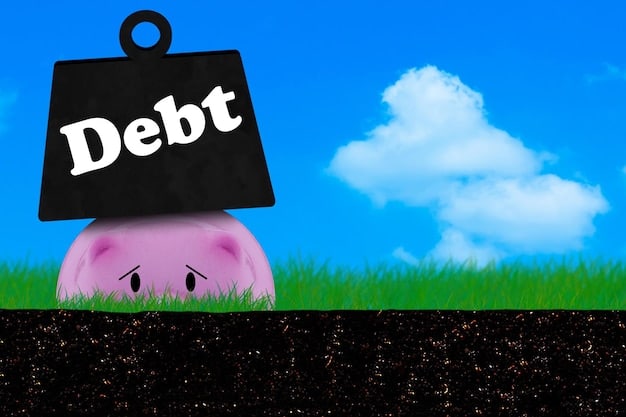Debt Avalanche vs. Debt Snowball: Which Saves More?

The debt avalanche method prioritizes paying off debts with the highest interest rates first, potentially saving you more money in the long run compared to the debt snowball method, which focuses on paying off the smallest debts first for quicker psychological wins.
Navigating the world of debt repayment can feel overwhelming, but choosing the right strategy can significantly impact your financial well-being. Two popular methods, the debt avalanche vs. debt snowball, offer distinct approaches to tackling debt, each with its own set of advantages and disadvantages. Which one saves you more in the long run?
Understanding the Debt Avalanche Method
The debt avalanche method is a strategic approach to debt repayment that prioritizes minimizing interest costs. It involves listing all your debts and then tackling the one with the highest interest rate first, regardless of the balance. This method ensures that you’re paying off the debt that’s costing you the most money over time.
How the Debt Avalanche Works
The debt avalanche method requires a clear understanding of your debts, including interest rates and balances. Once you have this information, you focus your extra payments on the debt with the highest interest rate, while making minimum payments on all other debts. As the highest-interest debt is paid off, you move on to the next highest, and so on.
For example, if you have a credit card with an 18% interest rate and a personal loan with a 10% interest rate, you would direct all your extra funds towards the credit card until it’s paid off. Only then would you focus on the personal loan.
Pros and Cons of the Debt Avalanche
- Pro: Maximizes savings by minimizing interest paid over the life of the debt.
- Pro: Can lead to faster debt repayment compared to other methods, especially with high-interest debts.
- Con: May be psychologically challenging if you have large high-interest debts, as progress can feel slow.
- Con: Requires discipline and a focus on long-term financial goals rather than immediate gratification.
The debt avalanche is best suited for individuals who are motivated by numbers and can maintain focus on long-term savings, even if they don’t see immediate results.

Exploring the Debt Snowball Method
The debt snowball method takes a different approach by focusing on psychological wins. Instead of targeting the highest interest rates, you list your debts from smallest to largest balance and focus on paying off the smallest debt first, regardless of its interest rate.
How the Debt Snowball Works
With the debt snowball, you make minimum payments on all debts except the smallest one, which you attack with full force. Once that debt is eliminated, you take the money you were paying on it and “snowball” it into the next smallest debt. This process continues until all debts are paid off.
For instance, if you have a credit card with a $500 balance and a student loan with a $5,000 balance, you would focus on paying off the credit card first, even if the student loan has a higher interest rate.
Pros and Cons of the Debt Snowball
- Pro: Provides quick psychological wins, which can be very motivating.
- Pro: Simplifies the debt repayment process, making it easier to stick to.
- Con: May result in paying more interest overall compared to the debt avalanche.
- Con: Can take longer to pay off all debts if high-interest debts are left for later.
The debt snowball is ideal for people who need immediate positive reinforcement to stay motivated and are more driven by emotions than pure numbers.
Debt Avalanche vs. Debt Snowball: A Detailed Comparison
While both methods aim to eliminate debt, they differ significantly in strategy and potential outcomes. Understanding these differences is crucial for choosing the right approach for your individual circumstances.
Interest Savings
The debt avalanche method typically results in greater interest savings over the long run. By targeting high-interest debts first, you reduce the amount of interest that accrues, leading to lower overall costs. This is the mathematically superior approach when purely considering financial efficiency.
Psychological Impact
The debt snowball method excels in providing psychological wins. Successfully paying off a small debt early on can create a sense of accomplishment and momentum, which can be particularly helpful for those who struggle with motivation. The early victories can make the entire process seem less daunting.
Complexity and Ease of Use
The debt snowball is generally simpler to implement. It requires only listing debts by balance, making it less complex than the debt avalanche, which necessitates knowing the interest rates of each debt. This ease of use can be a significant advantage for those who find financial management overwhelming.
Conversely, the debt avalanche requires more initial effort to identify interest rates and prioritize accordingly. However, once set up, the process is straightforward and can become a routine.
Real-World Scenarios and Examples
To illustrate the differences between these methods, let’s consider a few real-world scenarios. These examples will help you visualize how each strategy plays out and identify which might be more suitable for your situation.
Scenario 1: High-Interest Credit Card Debt
Imagine you have a $5,000 credit card debt with an 18% interest rate and a $10,000 student loan with a 6% interest rate. Using the debt avalanche, you’d focus on the credit card first, saving a significant amount on interest. The debt snowball would have you tackling a smaller debt (if you had one) first.
Scenario 2: Multiple Small Debts
Suppose you have several small debts, such as a $300 medical bill, a $500 credit card balance, and a $1,000 personal loan. With the debt snowball, you’d quickly eliminate the medical bill and credit card, creating a sense of accomplishment. The debt avalanche might have you focusing on the personal loan if it had a higher interest rate.
Scenario 3: Large, Overwhelming Debt
Consider a situation with a large amount of debt spread across multiple accounts, like a $20,000 car loan, a $30,000 student loan, and a $10,000 credit card debt. The psychological boost from the debt snowball might be more beneficial here, providing the motivation to stick with the repayment plan.
Making the Right Choice for Your Finances
Choosing between the debt avalanche and debt snowball methods depends on your financial priorities and personality. Consider your tolerance for delayed gratification, your motivation style, and your overall financial goals to make an informed decision.
Assess Your Financial Situation
Start by listing all your debts, including balances, interest rates, and minimum payments. This will give you a clear picture of your financial landscape and help you evaluate which method aligns best with your needs.
Evaluate Your Motivation Style
Are you motivated by numbers and long-term savings, or do you need immediate wins to stay on track? If you’re driven by data, the debt avalanche might be the better choice. If you thrive on quick results, the debt snowball could be more effective.
Consider Your Financial Goals
What are your long-term financial goals? Are you focused on minimizing costs and becoming debt-free as quickly as possible, or are you more concerned with maintaining motivation and building momentum? Your goals should guide your decision-making process.
| Key Aspect | Brief Description |
|---|---|
| 💰 Debt Avalanche | Prioritizes debts with highest interest rates for maximum savings. |
| ❄️ Debt Snowball | Focuses on paying off smallest debts first for quick wins. |
| 📊 Interest Savings | Debt avalanche typically saves more on interest in the long run. |
| 💪 Motivation | Debt snowball provides quicker psychological boosts. |
Frequently Asked Questions (FAQ)
▼
The debt avalanche method is mathematically superior because it focuses on paying off high-interest debts first, which minimizes the total interest paid over time and leads to faster debt repayment.
▼
Yes, the debt snowball method can be easier to stick with for some people because it provides quick psychological wins by paying off smaller debts first, which can be very motivating.
▼
If your smallest debt has the highest interest rate, both the debt avalanche and debt snowball methods would prioritize paying it off first, making it a win-win situation.
▼
Yes, you can combine both methods by prioritizing high-interest debts while also strategically paying off a smaller debt for a quick win to stay motivated.
▼
Tracking your progress is crucial because it helps you stay motivated, see how far you’ve come, and make informed decisions about your debt repayment strategy, ensuring you stay on course.
Conclusion
In the debt avalanche vs. debt snowball debate, the optimal choice hinges on your personal finance style: the avalanche provides greater long-term interest savings, appealing to the analytical-minded, while the snowball offers the quicker wins that behavioral finance suggests keeps many people motivated to stick with their plan.





